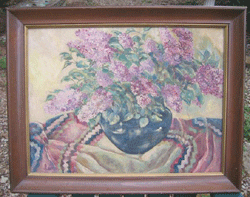Famous Anonymous Painters
By Harold Hollis
(Owner of R. Harold Hollis Antiques)
 One guy who buys from me occasionally once described my generic many of
them unsigned vintage landscapes and still lifes as "Harold's famous anonymous
art." "Sunday painters" is the name given all those talented folks whose art has
adorned the walls of America for many generations. The fancy term for a
self-taught person is "autodidact." Call it what you will, I just call it a
gift. One guy who buys from me occasionally once described my generic many of
them unsigned vintage landscapes and still lifes as "Harold's famous anonymous
art." "Sunday painters" is the name given all those talented folks whose art has
adorned the walls of America for many generations. The fancy term for a
self-taught person is "autodidact." Call it what you will, I just call it a
gift.
Like many collectors of Texana, I carry my Powers reference book on
early Texas art (John and Deborah Powers, Texas Painters, Sculptors and Graphic
Artists. Austin: Woodmont Books, 2000) with me. Of course, I am perpetually
hopeful that I am going to stumble on to something as I "check my traps"
periodically. Even though I have had a decent share of finding work by people
listed in the Powers book, rarely do I come across something that would be
welcomed in the big Texas art auction held in Dallas each fall. When I do, I
usually hang it on the wall of the barn I call home.
My knack seems to lead
me to works that, while sometimes signed, remain just another nice Texas
landscape, or still life, or perhaps something a little quirky. My loves are
many: bluebonnets and other notable Texas wildflowers, old houses and barns,
cowboys/cattle/horses, the coast, and things New Mexican. That gorgeous New
Mexico light some say it reaches its apex in Taos beckons me. And if you've
spent quality time in the high desert, you understand about the air and the
sound. This past summer, I roamed north central New Mexico for three weeks,
spending part of my time on the mesa at Carson, about 15 miles as the crow flies
from Taos. On that mesa, populated mostly by sage, chamisa, and a sprinkling of
dwellings, light and sound prevail, indeed arrest the senses. The view of the
Sangre de Christo mountains has been captured by many, but for me, a photograph
just doesn't convey the humbling majesty of the setting.
New Mexico abounds
with old-fashioned hollyhocks and lilacs. I'm a decent gardener who works
primarily with plant materials native or naturalized to Texas. Living on the
cusp of central and East Texas, I'm able to enjoy plants that prosper in both
regions, including a variety of perennials, a few annuals, old garden roses, and
some desert scape. Hollyhocks and lilacs have not thrived in my garden, probably
because of the extreme heat and humidity of our summers. I've read that most
lilacs require a pronounced winter chilling period, not common in my part of
Texas.
I didn't have to travel to New Mexico, however, to find a couple of my
favorite paintings: one a bunch of hollyhocks; and the other, quoting the
inscription on the back of the painting, "lilacs in Maria's bowl," signed with
the painters initials "lem".
We have no idea how many miles our various
treasures travel. Wherever we live, if we make buying forays to other parts of
this great country, we can assume that at least some of what we buy is
indigenous to the areas we visit. How does a bluebonnet landscape end up at a
New York City flea market? I don't know, but I found one there, and it has hung
in my mother's home for many years. My painting of hollyhocks showed up in an
antiques mall in East Texas, but I suspect it somehow got there from "back
east," not New Mexico. The lilacs adorning "Maria's bowl," I have to suppose
that Maria to be Maria Martinez (1887-1980) of San Ildefonso Pueblo renown. The
bowl looks like her work anyway. So whoever you are, and from wherever you hail,
"lem," thank you for your almost anonymous art, and thank you for taking time on
Sunday to share your gift.

|